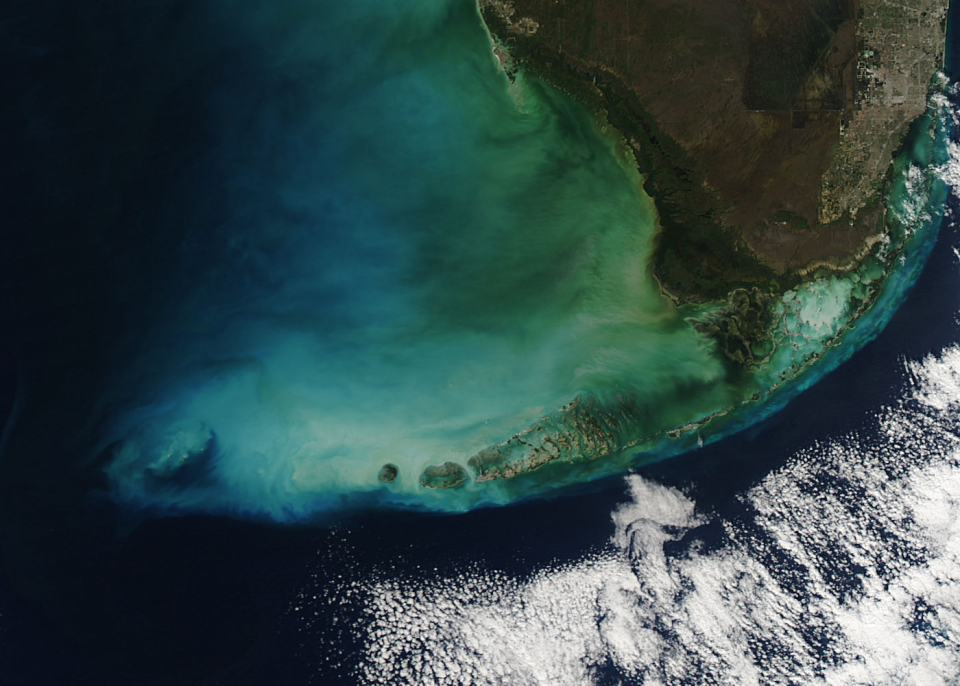Publié le 18 septembre 2023
By the time they were over, a series of massive algal blooms along the west coast of Florida in 2020 would be linked to some 2,000 tons of dead marine life around Tampa Bay. The human costs were stark, too, including a double-digit increase in asthma cases in Sarasota and Pinellas counties, and estimated losses of around $1 billion across economic sectors from tourism to fisheries.
Earth-orbiting satellites have been used for decades to detect algal blooms from space, enabling more frequent observations over broader areas than is possible by directly sampling the water. The most common observing technique relies on the visible spectrum to measure ocean color. However, this approach has been mostly restricted to clear sky conditions.

NASA’s MODIS instrument captured this image of the southern tip of Florida curving into a blue-green ocean edged by white clouds. MODIS and a new generation of satellite-based sensors can help environmental managers track noxious algae in the Gulf Coast and beyond.
Credits: NASA
A recent study, led by scientists at NASA’s Jet Propulsion Laboratory in Southern California, has shown how one space-based instrument called TROPOMI, or TROPOspheric Monitoring Instrument, was able to peer through thin clouds to uncover powerful clues about Karenia brevis (or K. brevis), the microscopic algae responsible for the 2020 blooms. TROPOMI’s enhanced ability to “see” and measure fine wavelengths of light could potentially help federal agencies and local communities better forecast and manage harmful outbreaks. (TROPOMI flies aboard the Copernicus Sentinel-5P spacecraft, which was launched in 2017.)
The scientists examined the West Florida Shelf, a stretch of continental crust arcing from the Panhandle to the Keys. From its origins in other parts of the Gulf of Mexico, K. brevis is carried toward the coastline on strong winds and ocean currents. Recent research has shown that western Florida, like many coastal communities, may be increasingly vulnerable to outbreaks because these algae flourish in nutrient-rich, warm conditions fueled by runoff, fertilizer, and climate change.
Systems for monitoring and forecasting harmful algal blooms are available in many states and coastal regions, including the Gulf of Mexico and Great Lakes. The National Oceanic and Atmospheric Administration (NOAA) works with academic, state, tribal, and local partners to develop and issue harmful algal bloom forecasts – similar to weather forecasts – during the seasons when blooms occur.
K. brevis events are especially concerning because the algae produce a potent neurotoxin that in high concentrations can cause massive fish kills and poison marine life such as turtles, manatees, and birds. The toxin can also be inhaled, causing respiratory illness in humans, and it can accumulate in shellfish, resulting in gastrointestinal illness in people who consume them.
As the algae feed and grow via photosynthesis, K. brevis emits a faint red glow called solar-induced fluorescence (red SIF) that can be detected by some satellite instruments including TROPOMI, which was actually designed to measure air pollution.
Sifting through TROPOMI data acquired along the coast of western Florida between 2018 and 2020, the team found that the instrument gathered about twice as much fluorescence information emitted by the algae as observed by previous methods that rely on ocean color. TROPOMI’s advanced imaging capabilities – including four spectrometers measuring light ranging from the ultraviolet to shortwave infrared – enable it to penetrate thin cloud cover and obtain measurements of the ocean surface more frequently.